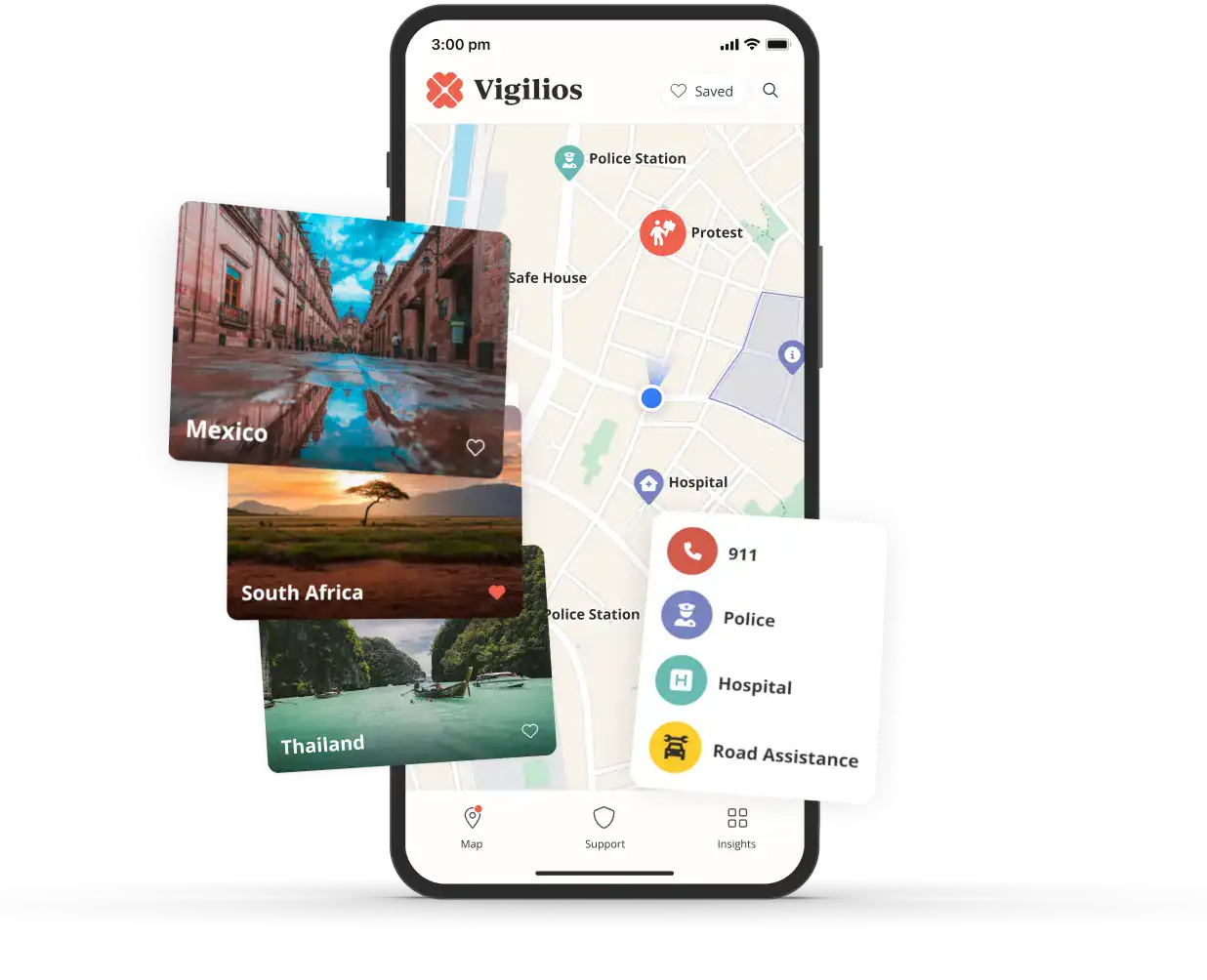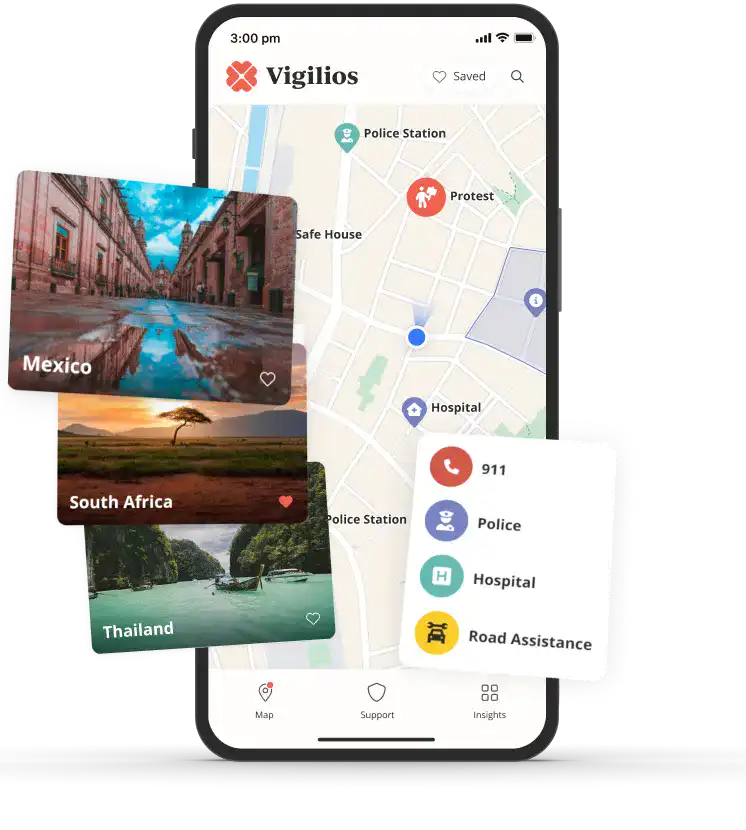Tipping in Mexico: Your Essential Guide on When and How Much to Tip

Table Of Contents
Tipping is an important part of service culture in Mexico, where a 10-15% tip is standard practice.
Service charges are not commonly included in Mexican bills, so it’s important to check whether you need to add a tip.
Cash tips are preferred. So carry small bills (coins are a no-go) to ensure the tip goes directly to the service worker.
Tipping in Mexico isn't just a courtesy. It's a crucial component of the earnings for many service employees. Let's explore the key aspects of tipping in Mexico, offering practical advice to navigate this important cultural practice.
Key Takeaways
10% is considered a standard tip for average service.
15% is considered a good tip for above-average service.
20% or more can be given for exceptional service.
Understanding Tipping Customs in Mexico
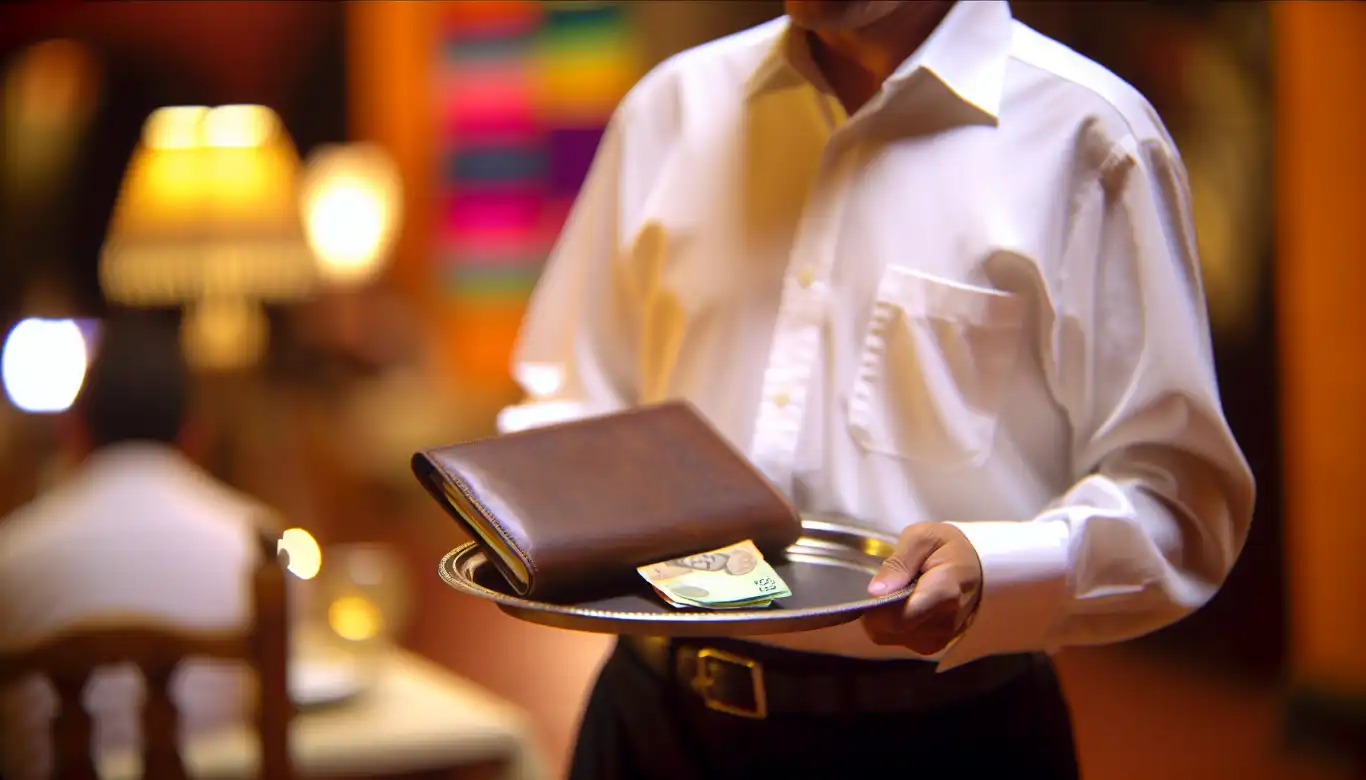
Mexican service culture shares similarities with the USA when it comes to deeply embedded tipping customs. In fact, tipping is expected and appreciated across Mexico, reflecting the country’s strong service-oriented culture.
Tips often act as a vital addition to the modest wages of waitstaff, hotel workers, and other service employees. The general attitude from locals toward tipping is proactive, with a common practice of adding approximately 10% to the bill.
As a rule of thumb, a tip amount of 10-15% of the bill is agreed upon by both locals and tourists.
However, the amount of the tip does not strictly adhere to a fixed percentage; instead, it often depends on the perceived quality of service. Hence, tipping behavior can be influenced by pleasant interactions, which are highly valued.
Tips in Mexico can be given directly in cash or added to a credit card bill. Opt for tipping in cash to ensure that the tip goes directly to the employee. While tipping in local currency - Mexican pesos - is preferred, alternatives like U.S. dollars are also accepted in certain locations.
"As a traveler, I learned that tipping just a few pennies in Mexico is a no-go. Aim for no less than five pesos — anything smaller might unintentionally insult the person you're trying to thank."
So, remember ‘la propina', the Spanish term for ‘tip’, and you’ll tip in Mexico like a local.
Decoding Service Charges: Is Your Tip Included?

Service charges are an important aspect of the tipping discussion. In Mexico, service charges are not typically included in bills, so customers should always verify whether they need to add a tip.
In some instances, a service charge might be added to the bill for large groups, or at certain restaurants and hotels, usually around 10%. When a service charge is already included, you have the freedom to leave an extra tip if you believe the service exceeded your expectations.
Before settling on the final tip amount, always make sure to review the check carefully. This practice will help you determine whether a service fee has been automatically added and avoid any potential double-tipping scenarios.
So, the next time you dine at a charming café in Puerto Vallarta, ensure you’re well-versed with the service charges before deciding on your tip.
The Ultimate Tipping Cheat Sheet
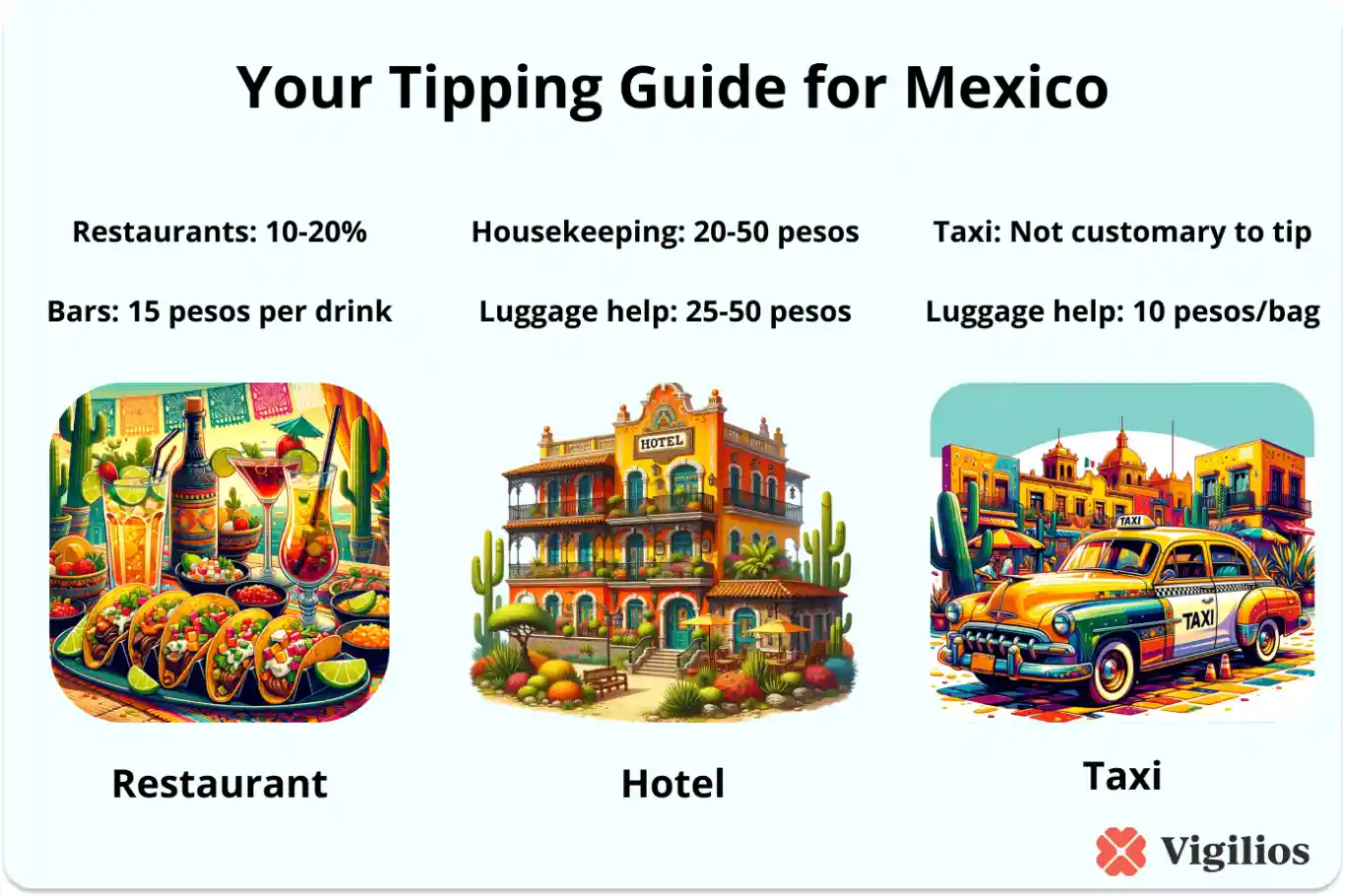
Now, let's dive into the most common services you're likely to encounter as a tourist. Whether you're savoring street food, dining in upscale restaurants, staying at all inclusive resorts, or exploring Mexico City with a local guide, this cheat sheet ensures you can tip confidently and appropriately. This guide aligns with local norms and helps you express your gratitude for excellent service in various settings.
Tipping in Local Restaurants vs. Tourist Areas
The etiquette of tipping in Mexico can fluctuate based on the location. The percentage of tip expected can differ in local restaurants compared to tourist areas.
In tourist-heavy beach destinations, a 15-20% tip is customary. However, in Mexico City and other less tourist-oriented areas, a tip of 10-15% is deemed sufficient.
Sit Down Restaurant Tipping Culture

The typical tipping range in Mexican sit-down restaurants is 10-15%, with a higher rate of around 15-20% for extraordinary service. This range can vary slightly depending on the location.
Tourist areas generally see a higher tipping rate of 15-20%, while in less touristy areas of the country, a tip of 10-15% in a local restaurant is greatly appreciated.
While a generous tip is always appreciated, be cautious not to over-tip beyond 20% as it can alter the service dynamic unfavorably for domestic travelers.
So, when dining at a sit-down restaurant in Mexico, keep these guidelines in mind to ensure your tipping practices align with local expectations:
Street Food and Casual Eats
Tipping practices deviate slightly when dining at casual eateries or enjoying street food in Mexico. A tip of around 10-15% is considered generous for good service at these establishments.
For single, small purchases like a taco from a street vendor or a drink from a bar, leaving a modest tip of coins or about 20 pesos is considered customary.
While contributions to tip jars labeled ‘propina’ at casual eateries and street food stalls are voluntary, they are definitely appreciated.
Meals
Drinks
Personal services
Transportation within the resort
Now, let’s delve deeper into the specifics of tipping at all-inclusive resorts.
A tip of 10%-15% is appreciated for waiter services.
For exceptional waiter service during sit-down dinners, consider tipping $3 to $5 per person.
Before you tip, though, it’s advisable to review the resort’s gratuities policy to ensure appropriate tipping practices.
Tipping at All-Inclusive Resorts
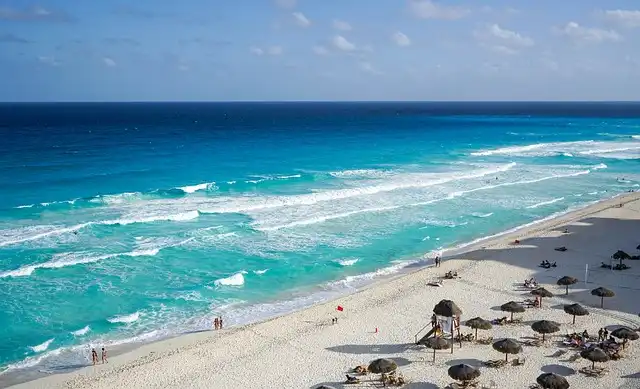
Tipping correctly at all-inclusive resorts in places like Cancun can feel like a complex task. While staff may appreciate tips, some resorts have a no tipping policy where tipping is not required or expected. However, customary tips are given for:
Room Service and Housekeeping Staff
Tipping room service and housekeeping staff at these resorts is an optional but always welcomed gesture of appreciation. As these staff members often earn modest wages, a common practice is tipping them 20 to 50 pesos per day to supplement their income. It’s also advisable to leave a tip daily, allowing each housekeeper who services the room to receive their share of the gratuity.
The amount you tip may vary based on the type and quality of the hotel. A range of 40 to 50 pesos per day for housekeeping is recommended, with some suggesting up to 50-80 pesos to reflect excellent service.
Tipping Staff at Resort Restaurants and Bars
Tipping customs become a primary concern at resort restaurants and bars. Here are some guidelines to follow:
When it comes to bartenders at all-inclusive resorts, a tip of $1 to $2 per drink round is recommended, with increased amounts for more complex drink orders.
Navigating Tipping with Taxi and Cab Services

Hopping into a taxi in Mexico? Though cab drivers do not generally anticipate tips, they are always grateful for any given.
However, a tip becomes customary if the taxi driver provides additional services such as assisting with luggage. A small tip of 10-20 pesos is a nice way to say thank you when they help load your suitcases into the trunk or offer insightful local tips during the ride.
Interestingly, the tipping culture for Uber drivers in Mexico is similar to practices in the USA. As part of their fare goes to Uber, they often appreciate tips to supplement their income.
Tipping Tour Guides

Tipping tour guides serves as an expression of satisfaction with the service provided. In Mexico, tour guides should be tipped for their service, with 100 pesos per person being common for large group tours. For private tours, the tip can vary between 200-600 pesos per person based on the duration and level of service.
For a half-day private tour, it’s common to tip the tour guide between 200 and 400 pesos per person. However, on a full-day private tour, a tip of 300 to 600 pesos per person is appreciated, which acknowledges the guide’s service and the tour’s inclusiveness.
Remember, if a tour guide provides exceptional service, placing an additional standard 10% in the tip jar is a great way to show gratitude.
Tipping at Grocery Stores and Gas Stations

Did you know that even your spare change can make a big difference in Mexico? A small tip of about 5% of the sale or between 5 to 10 pesos is usually given to gas station attendants for filling up the tank. If they provide additional services such as cleaning your windshield, checking your tires, or topping up your oil, then a larger tip should be given as an appreciation for the extra work.
In Mexican grocery stores, baggers typically consist of teens or seniors who work only for tips and do not receive a standard wage. Therefore, it’s customary to tip 1 to 2 pesos per shopping or a suggested 15-20 pesos overall. If a bagger provides an additional service by taking bags out to your car, it is customary to tip them more, usually at least 10 to 20 pesos.
Tips on Tipping
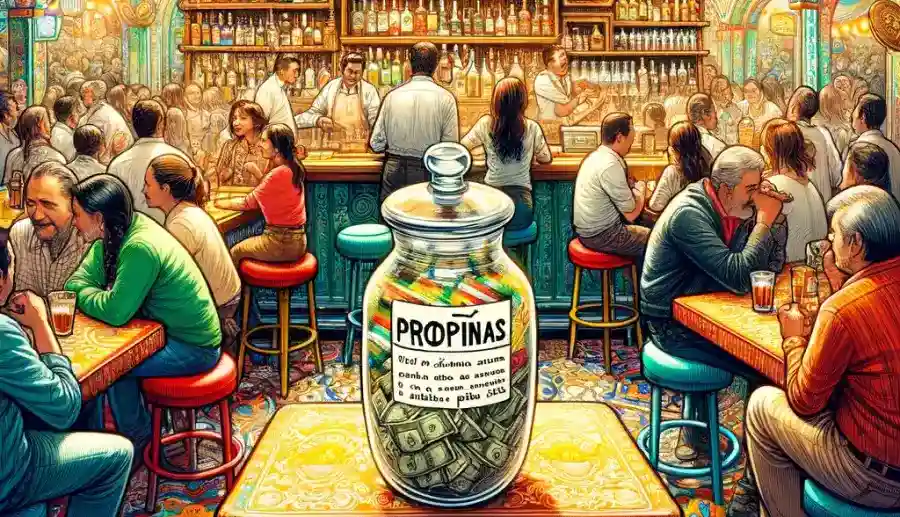
Now that we’ve covered the basics of tipping in Mexico, let’s look at some practical advice. Given the frequent occurrence of spontaneous tipping in Mexico’s informal, cash-driven economy, it’s vital to keep a supply of small bills and change while traveling.
You can get smaller bills and change from places like hotel or resort front desks, which can provide popular denominations like the 20 peso bill for tipping purposes.
Cash tips ensure that the **gratuity goes directly to the intended employee, preventing distribution among staff or deductions when added to a credit card bill. So, when you want to reward a specific service worker for excellent service, tipping with cash directly to the individual is preferred.
Your Next Trip to Mexico: A Summary of Tipping Situations
As we conclude our guide to tipping in Mexico, it’s time to recap the key points briefly.
Tipping is an expected practice in Mexico.
Rule of thumb is to tip 10-15%.
Tip in cash to directly enhance the wage of the workforce.
Preferably tip in Pesos.
So, whether you’re planning a leisurely stay at an all-inclusive resort, a cultural exploration with private tours, or simply enjoying the local cuisine, understanding the nuances of tipping etiquette will undoubtedly enhance your visit to this vibrant country. By following these guidelines, you’ll be able to navigate these situations with ease.
Frequently Asked Questions

How much to tip in Mexico?
In Mexico, the service personnel expects tip 10% to 20% of the bill, with 15% being a good standard in tourist areas. So, it's up to you, but aiming for 15% is a good rule of thumb when tipping.
How much do you tip in restaurants?
In restaurants, locals tip around 10% of the total bill. However, in areas with higher international tourism, it's often customary to tip up to 15%.
How much do you tip in bars?
For bars, leaving about 20 pesos per drink is customary to tip.
Is it better to tip in pesos or dollars in Mexico?
It's better to tip in pesos in Mexico. However, tipping in dollars is acceptable in most tourist areas, but it's more practical for the recipient to receive pesos. Just remember to use notes and not coins when tipping.
How much do you tip taxi drivers in Mexico?
Taxi drivers typically do not expect tips, unless they assist with luggage. If that's the case, a 10-peso tip per bag is courteous.
Is tipping mandatory in Mexico?
Tipping is not mandatory in Mexico, but it is a customary practice and greatly helps service workers make a living.

